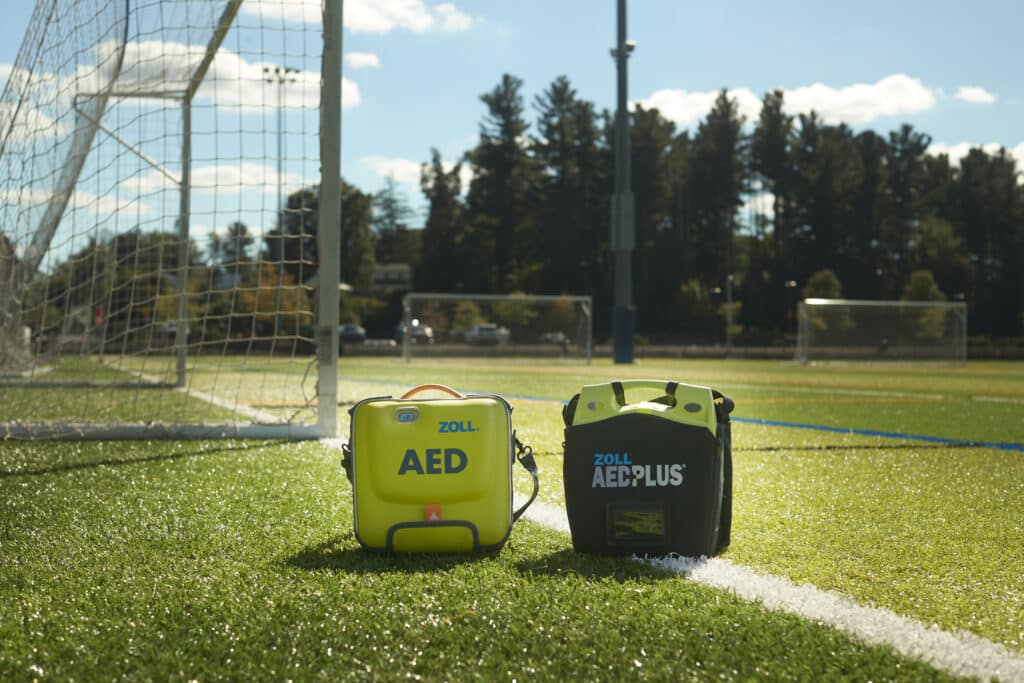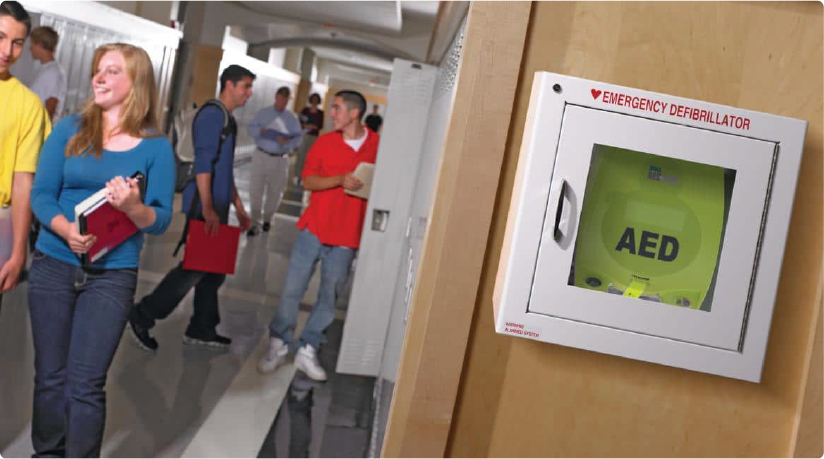An AED(Automated External Defibrillator) and an AED program are related concepts but serve different purposes within a workplace, public space, or medical environment. Below is a detailed explanation of their differences:

1. Definition
AED:
An AED is a portable, life-saving device designed to treat people experiencing sudden cardiac arrest (SCA). It delivers an electric shock to the heart in an attempt to restore a normal rhythm. The device is user-friendly, with voice prompts and visual instructions to guide the operator through the process, even if they have no medical training.
AED Program:
An AED program refers to the organized system or set of protocols that govern the use, maintenance, training, and oversight of AED devices within a particular environment (e.g., workplace, school, gym, or public space). It includes not just the devices themselves, but also the planning and preparation to ensure that AEDs are effectively deployed during a medical emergency and that users are trained and compliant with legal and safety standards.
2. Components
AED:
The AED itself is the hardware that delivers the shock. It typically includes:
- Pads: Adhesive electrodes that are placed on the person’s chest to detect heart rhythms and deliver the shock.
- Battery: Powers the device.
- Battery life & AED Status indicator: Displays the remaining charge and/or working status of the AED.
- Display screen or prompts: Provides instructions to guide the user.
- Shock button (if semi-auto): Used to deliver the defibrillation shock.
AED Program:
The AED program encompasses a broader strategy, including the following components:
- Device Placement: Deciding where AEDs should be located within the premises to ensure quick access in case of an emergency. This involves placing AEDs in easily accessible and highly visible locations.
- Training and Certification: Ensuring that employees or other personnel are trained in CPR (cardiopulmonary resuscitation) and the proper use of AEDs. This might include formal certification through organizations such as the American Heart Association or Red Cross.
- Maintenance and Inspections: Regular checks of AED devices to ensure they are functional and properly maintained. This includes monitoring battery levels, ensuring the pads are not expired, and confirming that the devices are ready for use.
- Emergency Response Protocols: Establishing and communicating clear protocols on how to respond during a cardiac emergency. This includes guidelines on activating emergency services (such as calling 911), using the AED, performing CPR, and notifying relevant personnel.
- Compliance and Documentation: Meeting legal and regulatory requirements for AED availability and usage, and maintaining documentation related to the training, maintenance, and usage of the AEDs. Many jurisdictions have laws that mandate certain safety protocols.
3. Purpose and Scope
AED:
The primary purpose of an AED is to treat sudden cardiac arrest by delivering an electric shock to the heart to restore its normal rhythm. It’s a piece of medical equipment with a very specific function: providing immediate care during a cardiac emergency.
AED Program:
The purpose of an AED program is to ensure that the device is effectively integrated into a wider emergency response system. It includes training people to use the AED properly, maintaining the device, and creating a system to respond quickly to an emergency situation. An AED program involves a comprehensive approach to improving survival rates in cases of sudden cardiac arrest by preparing the organization to respond efficiently and effectively.

4. Legal and Regulatory Aspects
AED:
The AED itself must meet specific standards set by regulatory bodies (e.g., the FDA in the U.S.) to ensure it is safe and effective for public use.
AED Program:
An AED program often has legal requirements that extend beyond the device itself. These may include:
- OSHA and State Regulations: Some states and jurisdictions mandate that certain businesses and organizations maintain AEDs and establish formal programs. The legal guidelines may include requirements for employee training, documentation of regular maintenance checks, and the ability to demonstrate compliance during inspections.
- Liability Protection: Most states offer “Good Samaritan” protections for people who use an AED in good faith to help someone in an emergency, but these laws may require certain standards to be met, such as training and the maintenance of the AED.
5. Maintenance and Lifespan
AED:
The AED needs to be regularly maintained to ensure it functions correctly when needed. This includes checking battery life, ensuring the electrodes are in good condition, and confirming that the device has not expired. Maintenance is often scheduled at set intervals, such as every 6 months or after each use.
AED Program:
An AED program encompasses the entire maintenance strategy for the devices, including ensuring regular inspections, scheduled testing of the devices, and keeping track of maintenance and expiration dates. The program also ensures that there is a system in place for replacing batteries or pads when needed and that the devices are easily accessible.
6. Training and Preparedness
AED:
Using an AED requires minimal training due to its automated design. The device provides step-by-step voice instructions to guide users through the process. It does not require the user to have medical training, although knowledge of CPR and the correct use of an AED is highly beneficial in an emergency. In fact, itCPR/AED Training is critical to a successful rescue for several reasons.
AED Program:
An AED program includes training people, often employees or specific responders, to effectively use the AED. This training may cover:
- Recognizing signs of sudden cardiac arrest.
- Performing CPR and using an AED.
- Understanding the emergency protocols and response plans.
- Handling AED device maintenance and inspections.
- Familiarity with local emergency response procedures (e.g., calling 911).
Regular training, along with practice drills, ensures that individuals are confident in using the device during a real emergency, improving the overall effectiveness of the response.
Key Takeaways
An AED is the life-saving device used during a cardiac emergency, while an AED program is the broader, organized system that supports the effective use of the AED. An AED program includes the proper placement, maintenance, regular inspections, training, and emergency response protocols to ensure that the AED is ready to be used in an emergency and that responders are adequately prepared. While the AED is essential, an AED program enhances its effectiveness by creating a structured, comprehensive approach to managing cardiac emergencies.


